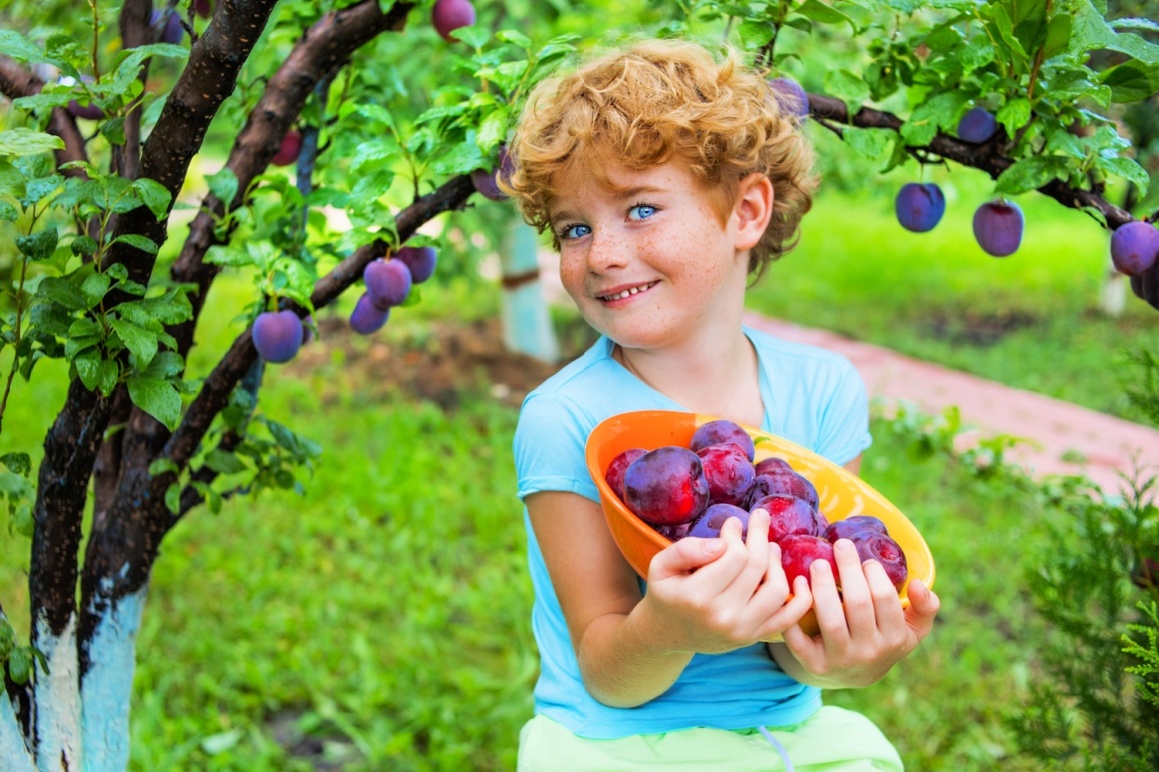Perfectly Plum Elixir

Perfectly Plum Elixir
For this fun and fizzy elixir, mash ripe plums with sugar to release their sweet juice, then add sparkling water. The result? A homemade soda that’s mouth-wateringly delicious!
Happy & Healthy Cooking,
Fun-Da-Mentals Kitchen Skills
- mash :
to reduce food, like potatoes or bananas, to a soft, pulpy state by beating or pressure.
- measure :
to calculate the specific amount of an ingredient required using a measuring tool (like measuring cups or spoons).
- stir :
to mix together two or more ingredients with a spoon or spatula, usually in a circle pattern, or figure eight, or in whatever direction you like!
Equipment Checklist
- Pitcher
- Dry measuring cups
- Cutting board
- Kid-safe knife
- Wooden spoon
Ingredients
Perfectly Plum Elixir
- 1/2 C granulated sugar
- 2 plums
- 3 C water
- 1 can sparkling water, flavor is optional
- ice, optional
Instructions
Perfectly Plum Elixir
measure + slice
Measure 1/2 cup sugar and pour into a pitcher. Then, roughly slice 2 plums, removing as much fruit as possible before discarding the pit. Add the plums to the sugar in the pitcher.
mash + stir
Mash the plums and sugar until a thick syrup forms. This is the plum syrup that will flavor the drink. Stir and mash as much as it takes to get the syrup to form.
pour + serve
Pour in 3 cups of water and 1 can of sparkling water. Stir a few times and serve! You can pour this one into cups as is or add ice. "Noroc'' (NO-rohk) or "Cheers'' in Romanian!

Hi! I'm a Plum!
"We can be a round or oval fruit with smooth yellow, green, red, or purple skin and yellow or red flesh, with a pit in the middle. We are a delicious summer fruit and when ripe, we are sweet and juicy! Some of us can be dried and eaten as dried plums (also called prunes)."
History & Etymology
- Plum trees may be one of the first fruit trees to be cultivated. The three main species of plums, Prunus domestica, Prunus salicina, and Prunus simonii, were not found in the wild but only near where humans lived.
- Plums are thought to have originated in Asia, Europe, and the Middle East. European plums were introduced to the United States in the 1700s. Japanese plums came to the US in the 1800s.
- The remains of plums have been found at archaeological sites from the Neolithic age (10000 to 2000 BCE).
- Plum cultivation was mentioned in a 12th-century agricultural book. Monasteries during the Middle Ages (400 to 1400 CE) grew plums, and Chaucer refers to a garden with "ploumes" in the 14th century.
- There are over 100 plum species in the world and over 2,000 varieties. About 15 species are native to North America, such as Prunus Americana.
- The Japanese plum (Prunus salicina) is the most common plum eaten in the US. European plums (Prunus domestica) are also available. The prune plum is a subspecies of Prunus domestica, which is often used to produce dried plums or prunes.
- China produces the most plums, over 54 percent worldwide. The US produces about a third of that amount.
- The word "plum" came from the Old English "plume," from the Latin "prunum," from the Ancient Greek "proumnon."
Anatomy
- The Plum tree is a flowering, deciduous tree that bears the plum fruit. It comes from the Rosaceae family and the Prunus genus. It is 16 to 20 feet high when pruned.
- Plum trees blossom in the spring. Their color may be white, pink, or pinkish-purple. Some varieties are grown for their ornamental value.
- A typical plum is about 1 to 1 1/2 inches in diameter. It is considered a "drupe" or stone fruit, like the apricot, cherry, nectarine, and peach. Drupes have a thin skin, fleshy inside, and a hard pit in the middle containing the seed. Prune plums are called a "freestone" drupe, as their pits can easily be removed from the flesh.
How to Pick, Buy & Use
- When harvesting plums, choose ones that are dark and rich in color, plump, give slightly when gently pressed, and have a pleasant, fruity fragrance. Their skin should be smooth, not wrinkly, and without blemishes. The same is true for choosing plums at the grocery store.
- To pick a homegrown plum, support the branch with one hand and gently grasp the ripe plum with the other hand, twisting it off the stem.
- Store ripe plums in the refrigerator for up to three days. Unripe plums will ripen on the kitchen counter. Add them to a paper bag with apples or bananas to speed up the process.
- Fresh plums are often eaten whole as snacks. Plums are very versatile in cooking. They can be baked, poached, sliced, broiled, stewed, or mashed.
- Plums can be cut up and added to hot and cold cereal, ice cream, cakes, cobblers, and pies. They can be added to meat dishes. Plum jam and plum wine are additional options.
Nutrition
- Plums are 87 percent water and about 11 percent carbohydrates and have a moderate source of vitamin C.
- Plums contain phytonutrients and antioxidants. They may aid digestion, reduce the risk of some cancers, and improve heart health.
Let's Learn About Romania!

- Romania is a country in Southeastern Europe. Ukraine is on its northeast border, Moldova is to the east, Hungary to the west, Serbia is southwest, Bulgaria is south, and the Black Sea is on its southwest border.
- Bucharest is the capital and largest city in Romania. The official language is Romanian. Several other European languages are also recognized in the country.
- Romania belongs to the European Union; however, its currency is still the Romanian "leu." They plan to adopt the "euro" in 2029.
- Romania's total area is 92,046 square miles, the 12th largest country in Europe. That is a little smaller than the state of Oregon. The population is over 19 million.
- The name "Romanians" refers to citizens of Romania and an ethnic group native to Central, Eastern, and Southeastern Europe. The people of this ethnic group mostly live in Romania and Moldova and have a shared ancestry and culture. They speak Romanian, one of the Romance languages.
- Transylvania is a cultural and historical region in central Romania. It became famous as the setting for Bram Stoker's novel, "Dracula." Due to the book's popularity, the area became associated with vampires.
- The geography of Romania has a mix of forests, hills, mountains, plains, and plateaus. The Carpathian Mountains go through its center, and Moldoveanu Peak is the highest at 8,346 feet.
- The delta of the Danube River lies primarily in Romania, with a small portion in Ukraine. The Danube is the second-largest river in Europe.
- There are nine UNESCO World Heritage Sites in Romania. Five of these are cultural sites, and four are natural sites.
- The country's economy is supported by agriculture, forestry, information technology, and construction, manufacturing, and service industries.
- Notable Romanians include poet, novelist, and journalist Mihai Eminescu; inventor and early airplane designer Traian Vuia; sculptor, painter, and photographer Constantin Brâncuși; music composer, professor, and violinist George Enescu; airplane builder, pilot, engineer, and inventor Aurel Vlaicu; and Olympic gymnast Nadia Comăneci.
- Romania's cuisine has Austrian, Balkan, German, Greek, Turkish, and other European influences. Many dishes have pork as the meat, and cheese (or "brânză" in Romanian), especially from sheep's milk, is popular.
- "Sarmale," stuffed cabbage rolls, are considered the national dish. "Ciorbă," a soup with different varieties, is made of meat, vegetables, and herbs. "Mititei," also called "mici," are grilled ground meat rolls, like caseless sausages. "Salata de vinete" is a roasted eggplant salad served as an appetizer. A "cornuleț" is a crescent-shaped bread roll, sometimes filled with jam and dusted with powdered sugar.
What's It Like to Be a Kid in Romania?
- Families and traditions are important in the life of Romanian children. Kids may experience vast differences in education and opportunities depending on whether they live in urban (city) or rural (countryside) areas.
- Popular sports include football (soccer), basketball, tennis, gymnastics, handball, and swimming. Kids may also play "oinǎ," a ball and bat game similar to baseball.
- For recreation or vacation, families may visit "Mamaia," a popular resort at a Black Sea beach. Ski resorts, castles, and preserved medieval Transylvanian cities are also popular attractions. Bran Castle is one of the most famous and is frequently publicized as Dracula's castle.
- Snacks for Romanian kids may include "covrigi" or Romanian pretzels, "plăcintă," a traditional pastry, and "gogoși," a cheese, chocolate, or jam-filled doughnut. For dessert, "amandine," a chocolate cake with almond and chocolate filling, is well-liked.




